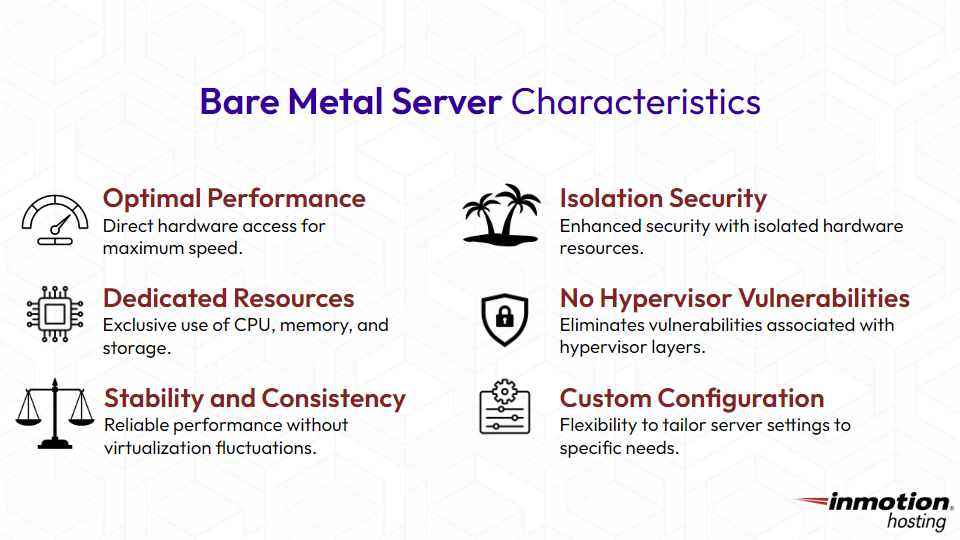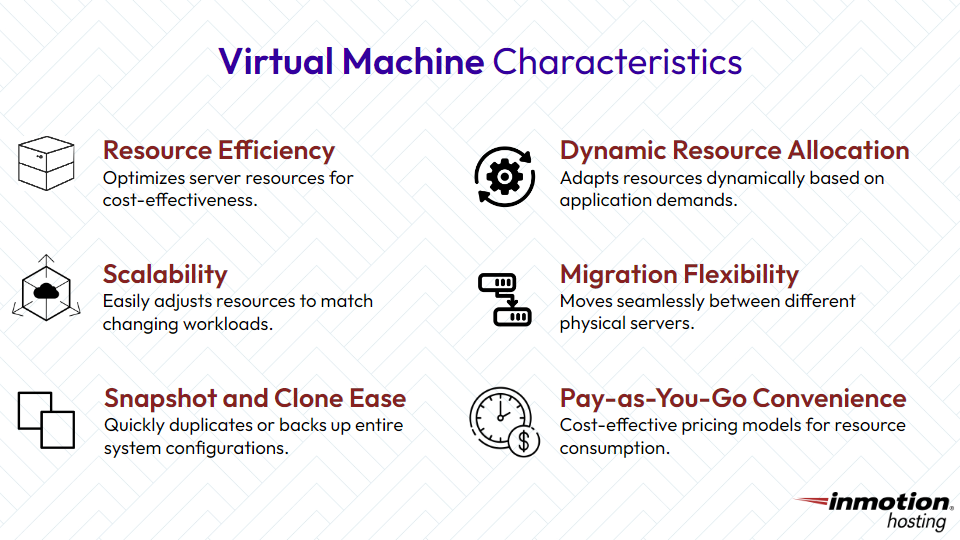Bare Metal Server vs. Virtual Machines

The choice between bare metal servers and virtual machines can be an important decision for businesses and IT professionals. Each approach comes with its own set of advantages and trade-offs, influencing performance, scalability, and resource utilization.
In this article, we’ll first discuss exactly what bare metal servers are and what virtual machines are.
Next, we’ll compare and contrast the following characteristics:
Finally, we’ll cover how to choose between bare metal and virtual machines.
What is a bare metal server? Bare metal servers, often referred to as dedicated servers or physical servers, represent a traditional form of hosting where an entire physical server is dedicated to a single user or organization. Unlike virtual machines, which run on a hypervisor layer, bare metal servers have direct access to the underlying hardware.
Key Characteristics of Bare Metal Servers
Performance
One of the primary advantages of bare metal servers is their superior performance. With direct access to physical resources, there is no overhead from a hypervisor, allowing applications to utilize the full power of the server’s CPU, memory, and storage.
Bare metal servers provide a high level of isolation, making them suitable for applications that demand dedicated resources and stringent security measures. This isolation also mitigates the “noisy neighbor” effect, where the performance of one virtual machine can be impacted by the activities of others on the same physical host.
Customization
Users have complete control over the server’s configuration, enabling customization to meet specific requirements. This flexibility is advantageous for workloads with unique resource needs or specialized hardware requirements.
Predictable Performance
Since there is no virtualization layer, the performance of bare metal servers remains consistent. This predictability is crucial for applications with demanding performance criteria, such as high-frequency trading or real-time processing.
Use Cases for Bare Metal Servers
High-Performance Applications
Bare metal servers are ideal for applications that demand maximum computational power, such as data analytics, scientific simulations, and rendering.
Database Servers
Database workloads benefit from the dedicated resources and predictable performance of bare metal servers, ensuring efficient data processing and retrieval.
Security-Sensitive Applications
Industries with strict security and compliance requirements, such as finance and healthcare, often opt for bare metal servers to maintain control over their infrastructure and data.
Resource-Intensive Workloads
Workloads requiring substantial computing resources, such as machine learning training or video transcoding, can leverage the full capacity of bare metal servers.
Understanding Virtual Machines
What are virtual machines? Virtual machines (VMs) are software-based instances that emulate the functionality of a physical computer. They operate on a hypervisor, a layer of software that abstracts and manages the underlying hardware, allowing multiple VMs to coexist on a single physical server.
Key Characteristics of Virtual Machines

Resource Consolidation
Virtualization enables the efficient utilization of physical resources by running multiple VMs on a single server. This consolidation leads to improved resource efficiency and cost savings.
Scalability
VMs offer a high degree of scalability, allowing organizations to dynamically allocate or deallocate resources based on demand. This flexibility is particularly beneficial for applications with variable workloads.
Snapshot and Cloning
Virtual machines can be easily cloned or snapshots can be created, providing a quick and efficient way to duplicate or backup entire system configurations. This feature enhances disaster recovery capabilities and simplifies the deployment of new instances.
Hardware Independence
VMs abstract the underlying hardware, making them hardware-independent. This abstraction facilitates migration between different physical servers without requiring modifications to the virtualized environment.
Use Cases for Virtual Machines
Server Consolidation
Virtualization is highly effective for consolidating multiple workloads onto a single physical server, reducing hardware costs and improving resource utilization.
Development and Testing
Virtual machines provide an isolated and reproducible environment for development and testing purposes. Developers can create and test applications without affecting the production environment.
Multi-Tenancy
Virtualization enables the hosting of multiple virtual machines on a single physical server, making it suitable for environments where different users or organizations share the same infrastructure.
Legacy Application Support
Virtualization allows organizations to run legacy applications on modern hardware, extending the lifespan of critical software that may not be compatible with the latest hardware.
Comparing Performance and Resource Utilization
Performance Considerations for Bare Metal Servers
Resource Utilization in Virtual Machines
Management and Flexibility
Management of Bare Metal Servers
Management of Virtual Machines
Security Implications
Security on Bare Metal Servers
Security in Virtual Machines
Cost Considerations
Cost of Bare Metal Servers
Cost of Virtual Machines
Making the Right Choice
Factors Influencing the Decision
Hybrid Approaches
The Future Landscape
As technology continues to evolve, new paradigms such as edge computing, serverless architectures, and advanced containerization technologies are shaping the future of IT infrastructure. Organizations must stay abreast of these developments to make informed decisions that align with their business goals.
Conclusion
The choice between bare metal servers and virtual machines is a nuanced decision that depends on the specific needs, goals, and constraints of an organization. Bare metal servers offer unparalleled performance, security, and control, making them suitable for applications with stringent requirements. On the other hand, virtual machines excel in resource efficiency, scalability, and cost-effectiveness, making them a popular choice for diverse workloads, especially in cloud environments.
Ultimately, the optimal solution may involve a combination of both approaches or the integration of emerging technologies such as containerization. By carefully evaluating the performance, management, security, and cost considerations outlined in this article, organizations can make informed decisions that pave the way for a resilient and scalable IT infrastructure.


